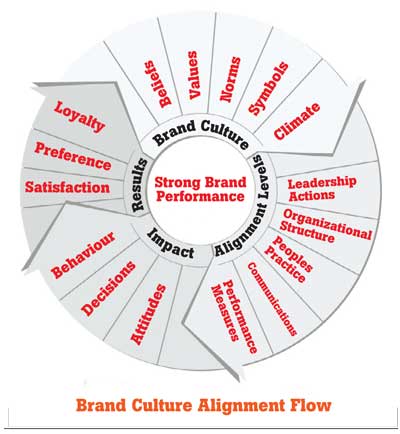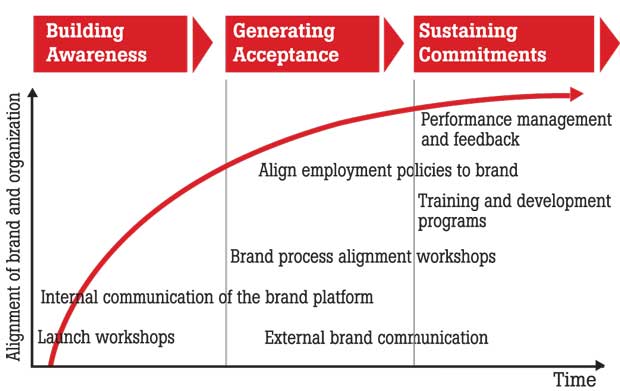Reply To:
Name - Reply Comment

As business and consumer markets become more competitive and customers become more demanding, companies must work harder to secure the fundamental relationships that fuel their business growth. Building distinctive relationships with customers is what branding is about, whatever the market, whoever the client.
What makes the difference between an average corporate brand and a great one? Employees who actively and enthusiastically engage in delivering the unique brand promise day in and day out. An average brand becomes a great brand by living its values; that is the key ingredient for world-class performance.
Aligning your organisation, operations and culture around your brand values brings the promise to life. A corporate brand stands for the relationship that an organisation has with its employees, as much as it represents the relationship that it has with its customers through its product and service offering. For a brand to come to life with customers, the organisation must be internally aligned to deliver the brand promise through the organisation’s culture, reward systems, key success activities and structure. The management must demonstrate their commitment to these values through behaviour as well as corporate communications, demonstrating sincerity–not just rhetoric. The world’s most valuable brands clearly demonstrate this every day. Their employees truly believe that delivering the brand promise to customers is their shared responsibility and they modify their behaviours to fulfil this promise.
These benchmark companies signal their commitment to their declared brand values in various ways.
They effectively use internal communications to raise employee morale and commitment through shared beliefs and vision.
They give managers and staff a deeper understanding of the brand promise and the behaviours and values the promise demands – and train them to adapt their behaviour.
They enable all employees to understand how their own work processes and responsibilities contribute to delivering the brand promise to customers.
They change company policies, for example, recruitment, training and rewards, so that the organisation is also behaving in line with its brand promise.

The Brand Culture Alignment Flow diagram shows how the alignment process works to deliver strong brand performance. When the employees understand and accept that the values are genuine, they align their attitudes and behaviour to the brand values. The result is greater satisfaction for both customers and employees, leading to employee and customer preference and loyalty.
To maximize the success of any corporate branding effort, you must develop an integrated programme of internal initiates that actively support the brand. These actions will move your employees from awareness of the brand vision, to acceptance of the values and behaviours in support of the vision, to a sustained effort in bringing your brand to life.
Based on our work with the world’s largest companies, we have identified four critical success factors that will help you to achieve the alignment of your organisation to your brand promise.
1. Senior management stewardship
Visible leadership will drive consistent behaviour. The top managers must demonstrate that internal brand alignment is a high priority for the entire company through their own commitment to brand goals, values and behaviours. Through words, matching actions and the initiatives they support, the senior managers can demonstrate that the whole company is serious about keeping its brand promise.
2. Aligning business and brand strategy
Brand strategy must fuel loyalty-based customer relationships by defining a relevant, differentiated and credible value proposition. Such success is achieved by ensuring the product and service quality is consistent with your brand promise. Select acquisition candidates that share similar values and attitudes to customers. Make new employees aware of the brand promise and values as soon as they join. Support customer expectations through every interaction and purchase. Failure to live up to the brand promise will quickly depreciate brand equity and ultimately, your bottom line.
3. Responsibility and accountability
Middle managers are key to delivering the brand promise. Their role is to infuse their teams and their operations with a practical commitment to living the brand. This protocol applies as much to back office functions as to sales and customer service. In this way, the brand becomes the platform for focusing staff attention outwards, towards the customer priorities that will secure future earnings. It often involves changes to processes, incentives, training and management style as much as communication.
4. Ongoing performance measurement and feedback
What gets measured gets done. A coherent brand evaluation programme with milestones, progress measures and celebrations of success is vital for sustaining the momentum of internal brand alignment. Regular customer feedback to monitor the effectiveness of your brand delivery serves two distinct and equally important purposes. It determines how successfully internal managers are translating business strategies into compelling value propositions. It also creates an employee feedback loop to assess customer acceptance of and satisfaction with the brand promise.